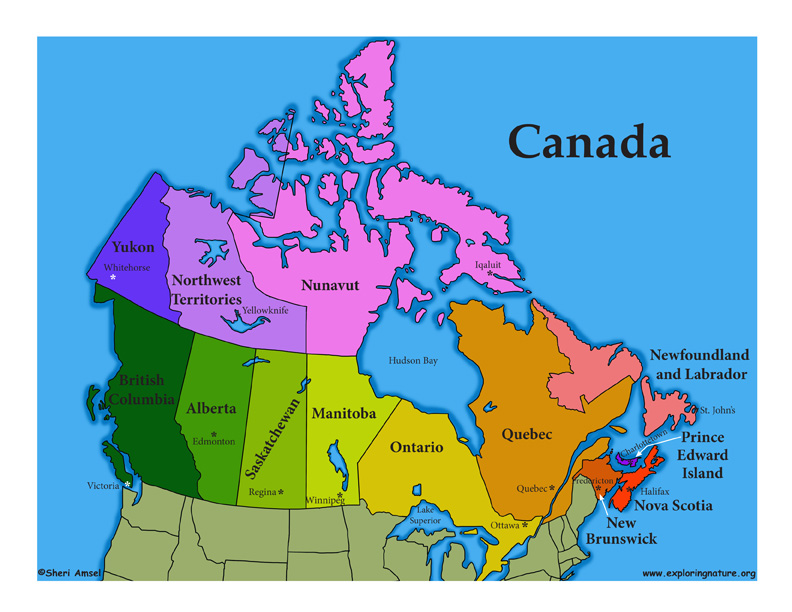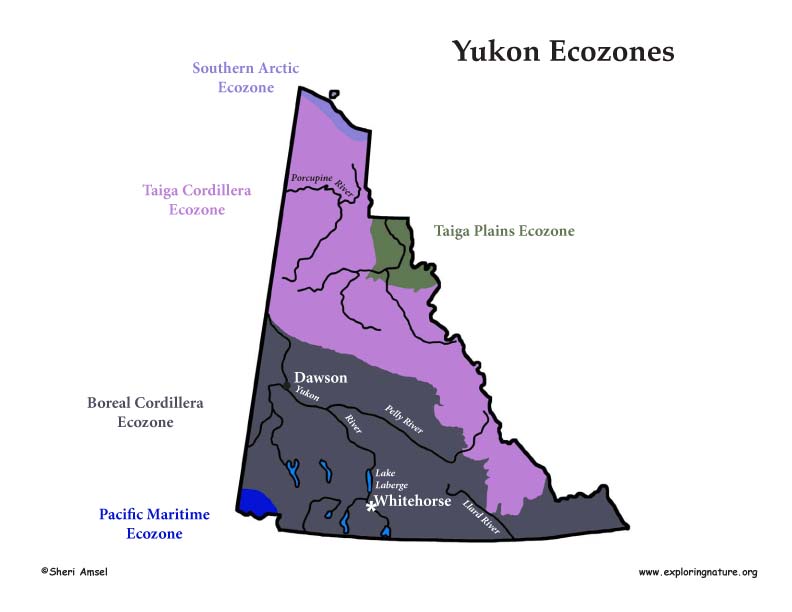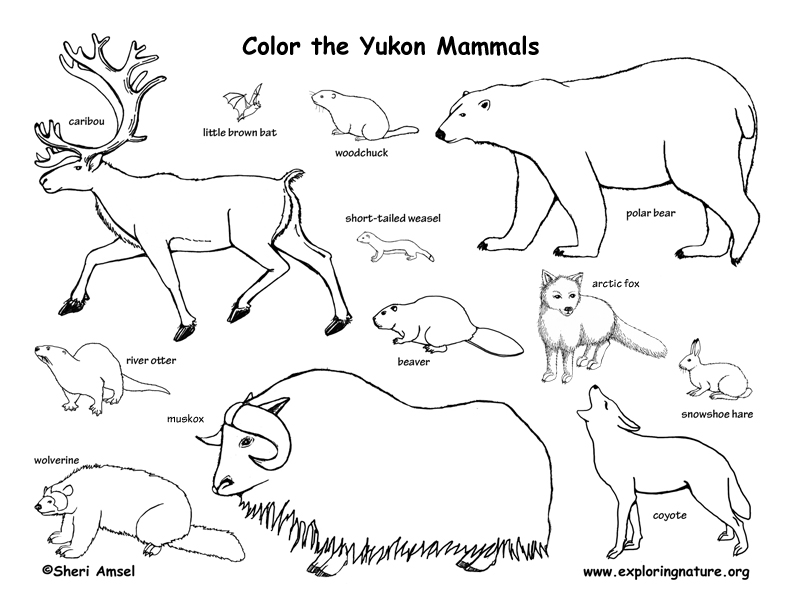

The Yukon Territory makes up the northwestern corner of Canada. It is bordered in the east by the Northwest Territories, marked by the continental divide. The southern border is with British Columbia and the western border is with the American state – Alaska. The capital is Whitehorse, where most of the people of the Yukon live.
It is the smallest territory of the three in Canada, but contains the highest point in the continent – Mount Logan at 19,551 feet (5,959 meters). The Yukon River runs down through the Yukon into Alaska and is fed by many large glacial lakes. It is the 5th longest river in North America.
The Yukon is a mountainous territory with 115 million acres (465,000 square km) of boreal forest. The territory has a herd of more than 100,00 barren ground caribou and is breeding ground for more than 150 species of birds. As many as 240 million birds breed there each year.
Scientists break down the Yukon into "Ecozones."
The most southwestern corner of the Yukon is Pacific Maritime Ecozone. The ocean keeps the climate more moderate (warmer in the winter and cooler in the summer), so tree growth in this region has the largest trees in the Yukon, including: western red cedar, yellow cedar, western hemlock, mountain hemlock, western yew, Douglas fir, grand fir, coastal redwood, Sitka spruce, lodgepole pine, western white pine , shore pine, Engelmann spruce, Garry oak, and Pacific dogwood. This coastal forest is considered temperate rainforest.
The Boreal Cordillera Ecozone includes the mountainous region in southwestern Yukon. The spine of mountains on the western edge of this Ecozone blocks coastal moisture, making this a relatively dry region with only about 11 inches (30 cm) of rain per year. As you move east toward the Canadian Rockies, the rain and snow levels increase. This region is characterized by towering mountains, open plateau and forested valleys – all littered with glacial debris. The valley forests include: white, black and Engelmann spruces, alpine fir, lodgepole and whitebark pines, quaking aspen, balsam poplar, white, water and scrub birches, and willows. Up higher, forests give way to stunted trees, shrubs and rugged moss, lichens and herbs. These mountains support many mammals including: caribou, moose, Dall’s sheep, mountain goat, bison, black and grizzly bear, lynx, wolf, fox, coyote, river otter, weasel, mink, marmot, marten, ground squirrel, beaver, lemming, pika, and snowshoe hare.
The Southern Arctic Ecozone starts in the coastal foothills of the Richardson Mountains in the Yukon and spreads across northern Canada to Ungava Bay in Northern Quebec. The Yukon has only a sliver of the Southern Arctic Ecozone on its northern coast of the Arctic Ocean. Here the winters are long, dark and frigid (-18° F/-28°C) and summers are short and cool (42° F/6°C) with long daylight hours. Only hardy plants survive here, like stunted trees, shrubs, lichens and mosses. Wetlands along the coast provide breeding and nesting grounds for waterfowl and barren ground caribou (from the Porcupine herd) have their calves on the open tundra. Other hardy wildlife also make a living here, like: polar bear, muskox, and arctic fox.
In the northeastern corner of the Yukon is the Taiga Plains Ecozone – a cold, dry prairie. This is a region that experiences fires regularly, so supports fire tolerant species like paper and dwarf birch, willows, quaking aspen, tamarack, green alder, white and black spruces, balsam poplar, lodgepole and jack pines, and balsam fir. It supports fewer mammals than more southern regions, but does include black bear, lynx, wolf, red fox, ermine, marten, woodland and barren-ground caribou, moose, snowshoe hare, red squirrel, and arctic ground squirrel.
The Taiga Cordillera Ecozone is the subarctic region along the northern Rocky Mountains. It covers most of the northern half of the Yukon and down its eastern border. This ecozone hosts some of Canada's most spectacular scenery - wild rivers, stunning waterfalls, and deep canyons. In the north the landscape is covered in tundra – low shrubs, lichens and mosses. As you travel south, it turns to boreal forest with alpine tundra topping the mountains. This varied landscape supports Dall sheep, caribou, mountain goat, moose, black and grizzly bear, wolf, Canada lynx, wolverine, pika, and marmot. Where the mountains give way to open valley floor in the Yukon (Old Crow Flats), a vast wetland supports tens of thousands of waterfowl (geese and swans) and other birds. The Arctic Mountain Ranges that span this ecozone are known for being one of the largest expanses of "unglaciated" mountains.
Mammals:
Bat (Little Brown) - Myotis lucifugus
Bear (Black) - Ursus americanus
Bear (Grizzly) - Ursus arctos
Bear (Polar) - Ursus maritimus
Beaver (American) - Castor canadensis
Bison (Wood) - Bison bison athabascae
Caribou (Barren-ground) - Rangifer articus
Caribou (Woodland) - Rangifer tarandus
Chipmunk (Least) - Tamias minimus
Coyote - Canis latrans
Deer (Mule) - Odocoileus hemionus
Elk - Cervus canadensis
Fisher - Martes pennanti
Fox (Arctic) - Vulpes lagopus
Fox (Red) - Vulpes vulpes
Hare (Snowshoe) - Lepus americanus
Lemming (Nearctic Brown) - Lemnus trimucronatus
Lemming (Nearctic Collared) - Dicrostonyx groenlandicus
Lemming (Northern Bog) - Synaptomys borealis
Lemming (Ogilvie Mountain Collared) - Dicrostonyx nunatakensis
Lynx (Canadian) - Lynx canadensis
Marmot (Hoary) - Marmota caligata
Marten (American) - Martes americana
Mink (American) - Neovison vison
Moose - Alces alces
Mountain Goat - Oreamnos americanus
Mountain Lion (Cougar) - Puma concolor
Mouse (Deer) - Peromyscus maniculatus
Mouse (Jumping) - Zapus princeps
Muskox - Ovibos moschatus
Muskrat (Common) - Ondatra zibethicus
Otter (North American River) - Lontra canadensis
Pika (Collared) - Ochotona collaris
Porcupine (North American) - Erethizon dorsatum
Sheep (Dall's) - Ovis dalli
Sheep (Stone's) - Ovis dalli stonei
Shrew (American Water) - Sorex palustris
Shrew (Arctic) - Sorex arcticus
Shrew (Barron Ground) - Sorex ugyunak
Shrew (Cinereus) - Sorex cinereus
Shrew (Dusky) - Sorex monticolus
Shrew (Tundra) - Sorex tundrensis
Squirrel (Arctic Ground) - Spermophilus parryii
Squirrel (Northern Flying) - Glaucomys sabrinus
Squirrel (Red) - Tamiasciurus hudsonicus
Vole (Eastern Heather) - Phenacomys ungava
Vole (Long-tailed) - Microtus longicaudus
Vole (Meadow) - Microtus Pennsylvanicus
Vole (Northern Red-backed) - Myodes nutilus
Vole (Singing) - Microtus miurus
Vole (Southern Red-backed) - Myodes gapperi
Vole (Taiga) - Microtus xanthognathus
Vole (Tundra) - Microtus oeconomus
Weasel (Least) - Mustela nivalis
Weasel (short-tailed or Ermine) - Mustela erminea
Wolf (Gray) - Canis lupus
Wolverine - Gulo gulo
Woodchuck - Marmota monax
Woodrat (Bushy-tailed) - Neotoma cinerea
For more details about the Yukon Territory's mammals: LINK
Birds:
avocet (American)
blackbird (Brewer's)
blackbird (red-winged)
blackbird (rusty)
blackbird (yellow-headed)
bluebird (mountain)
bluethroat
brambling
bunting (Lazuli)
bunting (snow)
chickadee (black-capped)
chickadee (boreal)
chickadee (gray-headed)
chickadee (mountain)
coot (American)
cormorant (double-crested)
cowbird (brown-headed)
crane (common)
crane (sandhill)
creeper (brown)
crossbill (red)
crossbill (white-winged)
crow (American)
dipper (American)
dove (mourning)
dove (rock)
dowitcher (long-billed)
dowitcher (short-billed)
duck (American wigeon)
duck (black scoter)
duck (Barrow's goldeneye)
duck (blue-winged teal)
duck (bufflehead)
duck (canvasback)
duck (cinnamon teal)
duck (common eider)
duck (common goldeneye)
duck (Eurasian wigeon)
duck (gadwall)
duck (greater scaup)
duck (green-winged teal)
duck (harlequin)
duck (King eider)
duck (lesser scaup)
duck (long-tailed)
duck (mallard)
duck (northern pintail)
duck (northern shoveler)
duck (redhead)
duck (ring-necked)
duck (ruddy)
duck (surf scoter)
duck (white-winged scoter)
duck (wood)
dunlin
eagle (bald)
eagle (golden)
falcon (gyrfalcon)
falcon (peregrine)
finch (house)
finch (gray-crowned rosy-finch)
finch (purple)
flicker (northern)
flycatcher (alder)
flycatcher (dusky)
flycatcher (Hammond's)
flycatcher (least)
flycatcher (olive-sided)
flycatcher (yellow-bellied)
godwit (bar-tailed)
godwit (Hudsonian)
godwit (marbled)
goldfinch (American)
goose (bean)
goose (Brant)
goose (Canada)
goose (great white-fronted))
goose (snow)
grackle (common)
grèbe (eared)
grèbe (horned)
grèbe (pied-billed)
grèbe (red-necked)
grèbe (western)
grosbeak (black-headed)
grosbeak (evening)
grosbeak (pine)
grosbeak (rose-breasted)
grouse (blue)
grouse (ruffed)
grouse (sharp-tailed)
grouse (spruce)
guillemot (black)
gull (Bonaparte’s)
gull (California)
gull (Franklin's)
gull (glaucous)
gull (glaucous-winged)
gull (herring)
gull (Iceland)
gull (ivory)
gull (lesser black-backed)
gull (little)
gull (ring-billed)
gull (Ross's)
gull (Sabine's)
gull (slaty-backed)
gull (Thayer's)
harrier (northern)
hawk (broad-winged)
hawk (northern goshawk)
hawk (red-tailed)
hawk (rough-legged)
hawk (sharp-shinned)
heron (great blue)
hummingbird (rufous)
jaeger (long-tailed)
jaeger (parasitic)
jaeger (pomarine)
jay (Clark's nutcracker)
jay (gray)
jay (Steller's)
junco (dark-eyed)
kestrel (American)
killdeer
kingbird (eastern)
kingbird (western)
kingfisher (belted)
kinglet (golden-crowned)
kinglet (ruby-crowned)
kittiwake (black-legged)
kittiwake (red-legged)
knot (red)
lark (horned)
longspur (Lapland)
longspur (Smith's)
loon (common)
loon (Pacific)
loon (red-throated)
loon (yellow-billed)
magpie (black-billed)
martin (purple)
meadowlark (western)
merlin
merganser (common)
merganser (hooded)
merganser (red-breasted)
murre (thick-billed)
nighthawk (common)
nuthatch (red-breasted)
oriole (Baltimore)
osprey
owl (boreal)
owl (great gray)
owl (great horned)
owl (long-eared)
owl (northern hawk)
owl (northern saw-whet)
owl (short-eared)
owl (snowy)
phalarope (red)
phalarope (red-necked)
phalarope (Wilson's)
phoebe (eastern)
phoebe (Say's)
pipit (American)
plover (American golden)
plover (black-bellied)
plover (Pacific golden)
plover (semipalmated)
plover (snowy)
ptarmigan (rock)
ptarmigan (white-tailed)
ptarmigan (willow)
raven (common)
redpoll (common)
redpoll (hoary)
redstart (American)
robin (American)
sanderling
sandpiper (Baird's)
sandpiper (buff-breasted)
sandpiper (least)
sandpiper (pectoral)
sandpiper (semipalmated)
sandpiper (sharp-tailed)
sandpiper (solitary)
sandpiper (spotted)
sandpiper (stilt)
sandpiper (upland)
sandpiper (western)
sandpiper (white-rumped)
sandpiper (wood)
sapsucker (red-breasted)
sapsucker (yellow-bellied)
shrike (northern)
snipe (common)
solitaire (Townsend's)
sora
sparrow (American tree)
sparrow (Brewer's)
sparrow (chipping)
sparrow (clay-colored)
sparrow (fox)
sparrow (golden-crowned)
sparrow (house)
sparrow (lark)
sparrow (LeConte's)
sparrow (Lincoln's)
sparrow (Savannah)
sparrow (song)
sparrow (swamp)
sparrow (white-crowned)
sparrow (white-throated)
starling (European)
surfbird
swallow (bank)
swallow (barn)
swallow (cliff)
swallow (northern rough-winged)
swallow (tree)
swallow (violet-green)
swan (trumpeter)
swan (tundra)
tanager (western)
tattler (wandering)
tern (Arctic)
tern (black)
tern (Caspian)
thrush (gray-cheeked)
thrush (hermit)
thrush (Swainson's)
thrush (varied)
turnstone (black)
turnstone (ruddy)
vireo (blue-headed)
vireo (Philadelphia)
vireo (red-eyed)
vireo (warbling)
vulture (black)
vulture (turkey)
wagtail (yellow)
warbler (bay-breasted)
warbler (black and white)
warbler (blackpoll)
warbler (Canada)
warbler (Cape May)
warbler (MacGillivray's)
warbler (magnolia)
warbler (mourning)
warbler (Nashville)
warbler (orange-crowned)
warbler (palm)
warbler (Tennessee)
warbler (Townsend's)
warbler (Wilson's)
warbler (yellow)
warbler (yellow-rumped)
waterthrush (northern)
waxwing (Bohemian)
waxwing (cedar)
whimbrel
willet
woodpecker (American three-toed)
woodpecker (black-backed)
woodpecker (downy)
woodpecker (hairy)
woodpecker (pileated)
wood-pewee (western)
wren (brown)
wren (marsh)
wren (winter)
yellowlegs (greater)
yellowlegs (lesser)
yellowthroat (common)
For more details about the Yukon Territory's birds: LINK
Amphibians:
frog (boreal chorus) - Pseudacris maculata
frog (Columbia spotted) - Rana luteiventris
frog (wood) - Lithobates sylvaticus or Rana sylvatica
newt (rough-skinned) - Taricha granulosa
salamander (long-toed) - Ambystoma macrodactylum
salamander (northwestern) - Ambystoma gracile
toad (western) - Anaxyrus (Bufo) boreas
For more details about the Yukon Territory's amphibians: LINK
Wild Science Workbook
Activities that Bridge Outdoor Exploration with Classroom Science
The activities in Wild Science will integrate outdoor exploration with the understanding and appreciation of science and environmental issues.
Using Wild Science as a guide, we invite you to rediscover your sense of wonder about the natural world and share it with the children you know.
When you research information you must cite the reference. Citing for websites is different from citing from books, magazines and periodicals. The style of citing shown here is from the MLA Style Citations (Modern Language Association).
When citing a WEBSITE the general format is as follows.
Author Last Name, First Name(s). "Title: Subtitle of Part of Web Page, if appropriate." Title: Subtitle: Section of Page if appropriate. Sponsoring/Publishing Agency, If Given. Additional significant descriptive information. Date of Electronic Publication or other Date, such as Last Updated. Day Month Year of access < URL >.
Amsel, Sheri. "Canadian Territory - Yukon" Exploring Nature Educational Resource ©2005-2024. December 15, 2024
< http://www.exploringnature.org/db/view/1771 >










